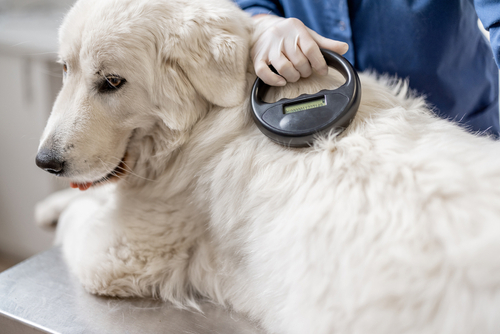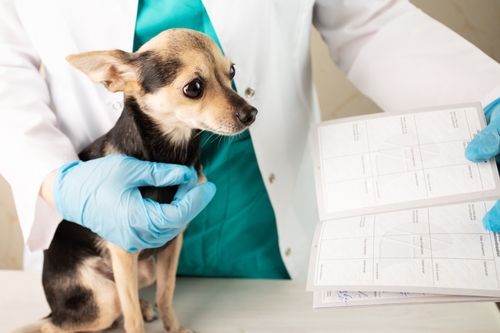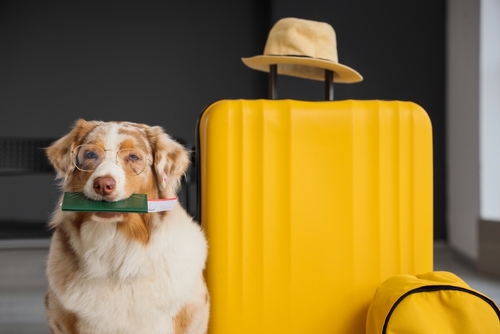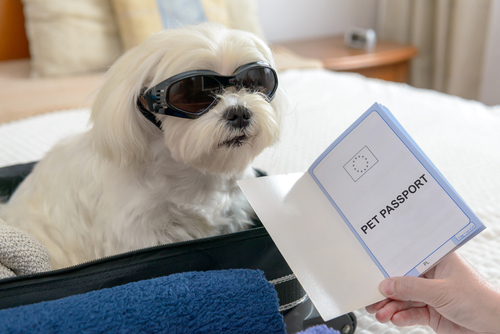If you have a dog, then you know that they are so much more than just a pet: they are a member of the family. The idea of travelling without them can be heartbreaking. Fortunately, airlines are becoming increasingly flexible when it comes to canine passengers, so you now have the option to take them on some international trips. What they will need, however, is a dog passport.
This article will take you through everything you need to know to get your dog a passport if you live in the UK, including the vaccinations and treatments they need, how to obtain official documentation, and the time and expenses involved. While the process might seem complex, if you follow Remitly’s step-by-step guide, your dog will be ready to travel in no time.
What is a dog passport?
Unlike your passport, a dog passport is less about identification and more about proving your dog is properly vaccinated and healthy to travel internationally. “Dog passport” is the common term for the group of documents required for canine travel. Exactly what documents your furry friend needs depends on their destination.
All dogs need to be microchipped, but to travel to the European Union, they need a valid Animal Health Certificate (AHC), to travel to the United States, they need a Certificate of Veterinary Inspection, to travel to Australia, they need a more comprehensive Veterinary Health Certificate, and they still undergo a mandatory quarantine period. Therefore, it is important to research the requirements for your destination well before you travel.
In addition, not all dogs are eligible to travel. In almost all cases, dogs need to have had the rabies vaccine to travel. Since dogs can only receive the vaccine after 12 weeks, young puppies are unable to travel. The USA requires that dogs be at least six months old to enter the country. In addition, some countries place limits on certain breeds. For example, Spain requires breeds such as pit bull terriers and rottweilers to obtain a special permit and wear a muzzle in public.
In addition, dog passports are only for non-commercial movement of animals. If you intend to take a dog overseas to sell, different paperwork is required.

How to get a dog passport: essential requirements
While the exact requirements vary depending on the destination country, three main requirements generally apply across the board.
Microchip identification
To travel, your dog needs to be microchipped, and most countries require an ISO (International Organization for Standardization) 11784/11785 compliant microchip. These microchips, which must be implanted, operate at a 134.2 kHz frequency, contain a unique 15-digit number, record data in a standard format, and can be read by international scanners.
The microchip records information such as your dog’s details, your contact details, and often your dog’s medical history.
If your dog already has a non-ISO chip, they can still get an ISO microchip implanted, as the chips do not interfere with one another. An authorised vet can implant your dog’s microchip.
Vaccinations
Your dog will also need certain vaccinations to travel, principally the rabies vaccine. The timing is important, as your dog’s vaccination must have been administered within the last 12 months, but at least 21 days before you travel. Again, an authorised vet can administer the vaccine and provide a valid rabies vaccine certificate as proof. This certificate will include their microchip number, the date the vaccine was administered, and the vaccine manufacturer.
Certain countries may also require additional vaccines, such as:
- Distemper: a viral disease that affects a dog’s respiratory, gastrointestinal, and nervous systems
- Hepatitis: an infectious virus that targets the liver
- Parainfluenza: a highly contagious respiratory virus often called “kennel cough”
- Parvovirus: a highly contagious and fatal virus that attacks the intestines
- Bordetella: a contagious respiratory illness
Tapeworm treatment is also required for dogs to enter several countries, such as Ireland, Finland, Malta, and Norway.
All the services you obtain for your dog to travel must be administered by a vet accredited by the Royal College of Veterinary Surgeons (RCVS) to be considered valid. If you don’t already have an accredited vet, you can use the Find a Vet tool, which allows you to search for vets that are part of the Practice Standards Scheme (PSS).
Health certificate
Your dog will also need a general certificate that confirms your dog is in good health and fit to travel.
In the case of traveling to the EU, this is an Animal Health Certificate (AHC), which was introduced in January 2021 following Brexit. It must be completed by an accredited vet, also known as an Official Veterinarian (OV).
The timing for obtaining this certificate is important. For the EU, it must be issued at least 21 days after your dog has received their rabies vaccination and within ten days of their travel date. It is valid for four months, and your dog must return home before the AHC expires.
The AHC itself is a document around 11-14 pages certifying that your pet meets the requirements to travel, which includes microchipping, rabies vaccination, and other requirements, such as tapeworm treatment. The AHC also includes a declaration from the owner that the travel is non-commercial. If someone else is travelling with your dog, you can indicate them as an authorised person. Whoever travels with the dog must travel within five days of the dog’s travel, which becomes relevant if your dog is not travelling in the cabin with you or the person you have authorised.
To take your dog to another country, you should apply for an Export Health Certificate. When you apply online, you will be asked to specify where you are travelling and your OV, who will then be able to provide the right kind of health certificate for your destination.
Return requirements
While these are the things that your dog needs to travel, remember that they may need other things to be allowed to return to the UK. For example, when returning from many EU countries, your dog will need tapeworm treatment from a local accredited vet within 24-120 hours of your return entry. Research these requirements in advance and find an accredited vet capable of delivering the service well before you travel.

Step-by-step process to get your dog’s travel documents
Step 1: Research your destination’s requirements
Once you decide to travel with your dog, start researching the requirements for your chosen destination. Don’t forget to research both what you need to do to enter your destination country and to return to the UK. (Learn more about pet import requirements for the UAE here.)
Step 2: Visit an accredited veterinarian for treatment
Once you have a good idea of what you need, it is time to find an accredited vet to deliver treatment. On your first visit, which should be at least a month before you travel, you can expect them to scan your dog’s microchip to confirm that it is present and working. They will check your dog’s medical history and give them a new rabies vaccine if necessary. They will then conduct a general health check to ensure your dog is fit for travel and schedule a return visit.
Step 3: Return to the vet and get your paperwork
Your next appointment will be within your travel window. For example, if you are traveling to the EU, it will be 21 days after the rabies vaccination and within ten days of your travel date. If you are traveling to other countries, the requirement could be 30 days after the rabies vaccination and within five days of your travel date. If your dog is traveling to a country that requires tapeworm treatment, they must receive it within this same timeframe. At the end of your appointment, you should receive your final documentation to travel.
Step 4: Don’t forget your return journey
Don’t forget that your dog may need further treatment to return to the UK. For example, for most EU countries, you will need to secure tapeworm treatment within 24-120 hours of your return trip, with an authorized vet who can sign the relevant part of your form. Know your travel timeline in advance, identify and contact a suitable local vet before you travel to organize the treatment.
Dog passport costs and timeline
In general, you should expect it to take around six weeks to get your dog travel documents. This gives you time to have your dog vaccinated for rabies and to be able to get to your final documentation.
The overall cost of a dog passport can range from £200-£300, depending on the rates at the vet you use and your insurance. For example, you can expect the rabies vaccination to cost £50-£90. The AHC certificate itself often costs around £100. For your return, tapeworm medicine will probably cost £15-£40, but there will probably be an additional fee for the appointment.
Common mistakes to avoid
While the process of getting a dog passport is not complex, there are common mistakes that tend to catch people.
Not researching your destination
Every destination has different rules, and not researching your destination thoroughly can lead to oversights that mean your dog can’t travel. For example, Australia has notoriously tight regulations when it comes to animals arriving, including a mandatory post-entry quarantine, which you must book and pay for as part of your travel preparation. The minimum quarantine period is 10 days, and it can sometimes be significantly longer.
Waiting until the last minute
People often don’t give themselves enough time to organize everything, and this can be a problem with the rabies vaccine. It needs to be administered at least 21 days before your dog travels to give their immune system time to develop protective antibodies. Not giving yourself enough time can delay your travel and result in your dog being left behind.
Using a non-accredited vet
Only accredited vets can issue treatments and documentation that will be considered valid for travel. While your vet may tell you that they can do it, always double-check their accreditation using the Find a Vet tool.
Incorrect paperwork
A single missing signature or incorrect date can invalidate all your paperwork. Double-check everything both when you receive it and before you travel.
Start planning your dog’s travel documents today
Pet parents are lucky that it is increasingly easy to travel with their dog, with smaller breeds even potentially sitting in the flight cabin with you. But there are strict travel documentation requirements for your dog to travel, which aim to prevent diseases from spreading and hurting dog populations in your travel destination.
The kind of documentation you need depends on where you travel, and some locations are simpler than others. For example, it is relatively straightforward to take your dog from the UK to the EU, while it is notoriously challenging to take them to Australia. Australia’s unique natural ecosystem means that they have stricter rules about animal entry.
The secret is to do your research and start preparing as soon as possible. While you must wait to do certain procedures, having everything planned in advance will reduce stress and the possibility of mistakes. Then you and your fur baby can set off on your adventure together.
Learn more about traveling with pets on the official UK government website.

FAQs
How long does it take to get a dog passport?
The short answer is that you need four to six weeks to get the necessary documentation for international dog travel. However, that can change depending on your destination, as different countries have different requirements and need different documentation. Start researching your destination requirements early to ensure you have enough time.
Can I travel with my dog without a health certificate?
No, your dog needs a health certificate to be able to travel internationally, as it will be checked at border control. The health certificate helps local authorities verify that your dog does not pose a risk to the local dog population or other animals or people.
What happens if my dog’s documents are rejected at the border?
If your dog’s pet travel certificate is denied at the border, the most likely outcome is that they will be sent back to where they came from at your expense. In some cases, there may also be a need for additional testing or exams, again at your expense. In extreme cases, for example, if your dog is found to have a dangerous and contagious disease, your dog could be put down.
Do puppies need the same documentation as adult dogs?
Yes, puppies need the same documents as adult dogs to travel. However, be aware that, in most cases, puppies under 12 weeks cannot travel as vets do not vaccinate them for rabies until they are 12 weeks old. Some countries have tighter restrictions. For example, the US does not accept puppies until they are at least six months old.
How much does it cost to get travel documents for my dog?
The exact cost of your dog’s travel documents will vary, as accredited vets set their own prices. A good estimate, including rabies vaccination and required documents, is between £200-£300.
